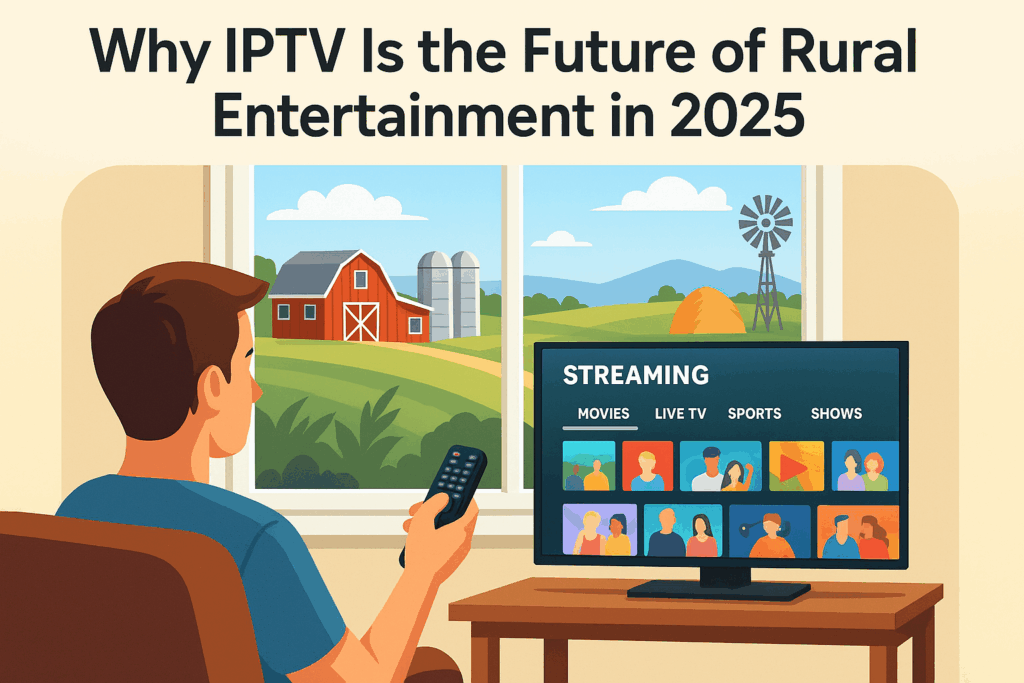
In 2025, access to entertainment is no longer limited by geography. Thanks to IPTV (Internet Protocol Television), rural and remote areas are experiencing a digital renaissance in entertainment. Once underserved due to poor infrastructure or limited access to cable and satellite services, these regions are now tapping into the immense possibilities offered by IPTV — revolutionizing how residents consume content. This article explores why IPTV is becoming the go-to entertainment solution in rural areas across the globe.
1. The Digital Divide: A Longstanding Issue
For decades, rural communities have been stuck on the wrong side of the digital divide. Traditional broadcasting services, especially cable TV, often fail to reach isolated areas due to logistical and infrastructural constraints. While satellite TV made some progress, high installation costs and limited local content made it an imperfect solution.
IPTV changes the game.
By leveraging the internet, IPTV delivers high-quality television and multimedia content through broadband, mobile networks, or even Wi-Fi hotspots, requiring minimal hardware. As governments and private sectors expand internet coverage into rural zones, IPTV becomes a logical step forward.
2. Low Infrastructure Costs, High Scalability
One of the key advantages of IPTV is the minimal infrastructure needed compared to traditional television systems. All a household needs is a stable internet connection and a compatible device — be it a smart TV, smartphone, tablet, or computer.
For rural communities, this is a game-changer. There’s no need for bulky satellite dishes, extensive wiring, or expensive service plans. IPTV platforms can also scale easily, allowing service providers to adapt to growing demands without major technological overhauls.
3. Local Content, Global Reach
IPTV platforms allow for the seamless integration of local and international content. This flexibility empowers regional broadcasters to serve their communities with relevant news, cultural programming, religious content, and regional music — all while giving users access to global networks like Netflix, BBC, Al Jazeera, and more.
In remote villages, local creators and small production houses can even start their own IPTV channels. This fosters not only entertainment but also cultural preservation and economic development through content monetization.
4. Smartphone Penetration in Rural Areas
According to recent research, smartphone adoption is growing rapidly in rural areas, especially in developing countries. IPTV services that are mobile-friendly or app-based (like YouTube TV, Hulu Live, or regional IPTV providers) allow users to stream content on the go.
This is especially important in rural households where TV ownership may be limited, but smartphone access is widespread. Many IPTV apps even offer offline viewing, ensuring that users with inconsistent internet access can still enjoy their favorite shows.
5. Education and Information Access
IPTV is not just about movies and shows — it’s a medium for education and awareness. In rural areas where schools may lack adequate resources, IPTV can deliver:
- Educational channels for children
- Vocational training videos for youth and adults
- Health and agricultural content tailored to local needs
- Government announcements and digital literacy programs
This transforms entertainment platforms into vital tools for social development.
6. Flexible Pricing and Free Content Options
Many IPTV platforms are either free (ad-supported) or come at a fraction of the price of traditional cable or satellite services. Rural users, often limited by income, can subscribe to packages that fit their budget or enjoy free IPTV channels that broadcast local news, music, and religious programs.
Community organizations or local governments can also subsidize IPTV services as part of public outreach initiatives.
7. Custom Playlists, Parental Control, and On-Demand Viewing
Unlike traditional TV, IPTV gives users control over what they watch and when they watch it. This is especially valuable for rural families with children or elderly members. IPTV services typically offer:
- Parental controls
- Content scheduling
- Language customization
- On-demand libraries for flexible viewing
These features make IPTV user-friendly and adaptable to the household’s preferences and values.
8. Supporting Rural Economies and Creators
As IPTV gains traction, rural entrepreneurs and content creators are jumping on board. From local cooking shows to agricultural tips, spiritual content to regional comedies — IPTV offers a platform for these voices to reach a broader audience and generate revenue through ads, sponsorships, or subscriptions.
This isn’t just entertainment; it’s economic empowerment.
9. Challenges to Address
While the potential is massive, a few hurdles remain:
- Internet connectivity is still inconsistent in some rural zones.
- Digital literacy may be low, requiring education on how to use IPTV services.
- Limited local-language content in some regions.
However, with the right partnerships between governments, ISPs, NGOs, and tech companies, these challenges are being addressed faster than ever.
Conclusion: A Screen in Every Village
IPTV is poised to become the backbone of rural entertainment in 2025 and beyond. By eliminating physical boundaries and infrastructure constraints, it empowers even the most remote communities with access to education, entertainment, and opportunity.
As internet coverage and smartphone use continue to rise, IPTV will not just be a luxury — it will become a necessity for inclusive digital development.
